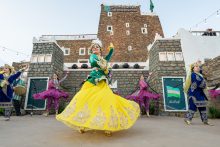 The third Qemam International Festival for Mountain Performance Arts, held in Saudi Arabia’s Asir region, presented a stunning array of performances from both local and international troupes. Featuring participants from 45 local and international groups and showcasing 40 distinct types of Saudis, Arab, and international mountainous performance arts, the festival’s goal was to foster international cultural exchange and celebrate the rich legacy of mountain performing arts.
The third Qemam International Festival for Mountain Performance Arts, held in Saudi Arabia’s Asir region, presented a stunning array of performances from both local and international troupes. Featuring participants from 45 local and international groups and showcasing 40 distinct types of Saudis, Arab, and international mountainous performance arts, the festival’s goal was to foster international cultural exchange and celebrate the rich legacy of mountain performing arts.
The Chinese group left a lasting impression with their mesmerizing performances. The first, a traditional Yao dance called “Long Drum” from the Han dynasty, showcased the group’s artistic prowess. Their second performance, “Bronze Drum,” seamlessly combined traditional art, music, and skilled group performance, providing a unique and enchanting experience.
Japan contributed to the cultural tapestry with a performance group presenting three distinct arts: Kokiriko Bushi, Hanagasa Ondo, and Genroku Hanami Odori. The Spanish group, on the other hand, enraptured the audience with three performances set to Spanish music tunes, showcasing the authenticity and heritage of these arts.
Sudan brought forth the ancient art of Sudanese Ardah, while Jordan presented the vibrant ‘Dabkah’ with about twenty variations. Lebanon’s performance group displayed the art of Dabkah at eight heritage sites, emphasizing its significance in the Levant. The Moroccan group exhibited the famous Ahidouss, Obidat Al-Rama, and captivating solo and group performances of Amazigh Mountains.
An Iraqi group presented the art of ‘Gobi’ at eight heritage sites, and the Yemeni performances depicted the rich legacy and heritage through ‘Al-Samrah’ from Yafi and Al-Awd Mountain performance arts.
Italy showcased three mountain arts – Mediterraneo Performance Arts, Old Ttarantella, and Ballad of SanCalogero. The Uzbekistani group delighted the audience with ‘Lyasgi,’ a performance that highlighted individual and group skills, adding an international flavor to the festival.
The Saudi performances at the festival were a testament to the country’s cultural diversity. Twenty performance groups from different regions presented traditional dances reflecting age-old customs and traditions.
Notable performances included Al-Dammah Performance Arts, known for its excitement and strength, and ‘ Al-Le’ab Al-Shehri,’ combining poetry and music, were highlighted, along with ‘Al-Khatwa,’ one of the most prominent southern performing arts from Aseer, Ardah from Al-Baha the famous performing art captivated the audience, it is a group art form with rhythmic tunes, along with ‘Msahabani,’ relying on rhythm., Al-Majroor from Taif, a leading performing art in the western region and Al-Dahah from northern regions.
The Jazan region showcased several arts, including Al-Rabsh,’ The Sword,’ and performances of & Al-Azzawi,’ forming a folk heritage that still narrates the cultural reality of a specific era, influencing the region’s people to this day.
Organized by the Theater and Performing Arts Commission, the festival aims to present Saudi heritage globally, attract international attention to local events, and emphasize the Kingdom’s efforts in preserving cultural heritage. The third edition aligns with Saudi Vision 2030’s cultural strategy, reflecting the Commission’s commitment to enhancing international cultural exchange.
The Qemam International Festival for Mountain Performance Arts continues to be a unique platform celebrating the diversity of mountain performing arts globally. With its annual showcase of traditional and contemporary performances, the festival plays a vital role in fostering cultural exchange and preserving the rich heritage of performing arts from around the world.
 Tourism Breaking News
Tourism Breaking News


